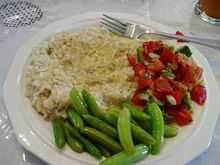Harissa (dish)

Harissa (Armenian: հարիսա harisa) is an Armenian dish from the Ararat plain.[1] It is similar to kashkeg, a kind of homogeneous porridge made of previously stewed and boned chicken or lamb and coarsely ground soaked wheat (typically, shelled wheat, though in some regions with a high Turkish population, pounded wheat, or yarma, is also used).
The dish has been passed on since ancient times. Harissa is traditionally served on Easter day. It is still prepared by many Armenians around the world and is also considered the national dish of Armenia.
Harissa is also very common in Lebanese villages, across its different ethnic communities, where it is usually cooked on religious occasions in a big pot in a village gathering. Additionally, Harissa is used by the Assyrians as a dish on Eeda Zoora, Christmas, and Eeda Gura, Easter. Harissa is very similar to a popular dish among Arab countries of the Persian Gulf known as harees which is made of meat and finely ground wheat.
Harissa is known for helping the Armenians of Musa Dagh to survive during the resistance of 1915.[2]